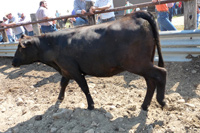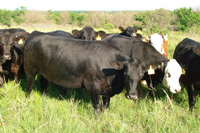By Allen Williams, Ph.D.
Over the past three months we have looked at the basics of seedstock genetic selection for producing the kind of cattle that are capable of meeting the demands of the grassfed beef market. This month we will concentrate on selecting for the stocker or feeder cattle that we are actually going to finish on forage.
And as with the seedstock, selection for cattle to finish is primarily a matter of proper phenotype and genotype. To determine the desired phenotype and genotype, we first have to identify the end-product target.
For consistent high-quality eating experiences, one should target cattle that finish at a minimum standard of USDA High Select to USDA Choice-plus. This means that finished cattle will possess at least a slight to moderate degree of marbling, fit securely into the “A” maturity range of no more than 30 months of age at harvest, and possess a light to moderate cherry red color and a moderately fine to very fine texture to the lean (http://meat.tamu.edu/beefgrading/). Meeting minimum standards of carcass quality is important for assuring uniformity and consistency in both red meat yield and eating quality.
To consistently achieve the desired degree of finish, most steers will need to weigh 1,100 to 1,250 lbs. and be 22 to 26 months of age when ready to harvest. As in breeding stock, animals selected for grass finishing should be very moderate in frame score, preferably between 3.0 and 5.5. (See Guidelines for Uniform Beef Improvement Programs, Ninth Edition, 2010, Chapter 3, pgs. 28-30, Beef Improvement Federation.)

This heifer needs another 150 pounds of gain to reach full finish.

This heifer is fully finished, with depth and fill in the heart girth and flank areas along with fullness over the top of the rump between the hooks and the pins (front and back of the pelvic structure) and fat cover over the hooks.
Larger-framed animals will have a hard time obtaining a high degree of finish on forage alone and will often have to weigh 1,300 lbs. or more, plus be 30 months or older before being ready for harvest. In addition, the phenotypically correct animal should be very deep-bodied with well-sprung ribs, and exhibit depth of both heart girth and flank. Animals that are tight-middled and pinched in the heart girth and flank typically will not finish well on grass.
Animals selected for grass finishing should also be sound of feet and legs, as they will have to cover ground each day to consume adequate amounts of forage dry matter for desired gains. Average daily gain targets for the finishing phase should be a minimum of 2.0 lbs./day, with a goal of up to 3.0 lbs./day.
Remove poor performers
Cattle that are not performing well on forage should be culled or sent to the feedlot. Once you become skilled at forage finishing and in recognizing a truly finished animal, you will find that as they get close to the 800- to 900-pound range, they will start to sort themselves out. It becomes apparent which animals will obtain a high degree of finish at 1,100 to 1,200 lbs. and which ones are simply too large or too tight-middled, and will thus take much longer to reach a desired degree of finish. The ones that start to fall out at 800 to 900 lbs. should be sold into other markets rather than attempting to finish them on grass.
To achieve optimum grass-finished targets for both live weight and carcass quality, one first has to understand what a properly finished animal looks like. Look for adequate fat cover over the ribs and back, around the tailhead, in the brisket, and in the cod of steers or udder of heifers. A well-finished animal will have a nice spongy fat cover over all ribs, with no ribs visible to the eye all the way back through the 13th rib. The top line of the animal should be either level in appearance or have a slight dip at the top of the spine. If a steer or heifer has a sharp appearance to the spine or top line, it is not adequately finished.
As a matter of fact, sharpness of any of the primary skeletal structures indicates lack of finish. There should be depth and fill in the heart girth and flank areas and fullness over the top of the rump between the hooks and the pins (front to back of pelvic structure), with fat cover over the hooks. The brisket should be wide, deep and distended, showing evidence of heavy fat deposits.
One of the final areas of fat deposit will be the region around the tailhead. In the feedlot industry, fat deposits on both sides of the tailhead are called “pones” or “poning.” An animal is very close to being fully finished when there is strong evidence of fat pones around the tail head.
Finally, to determine how good a job you are doing in producing animals that are uniformly and consistently finished, you must determine your optimum target endpoint. Do you want a leaner product (USDA Standard or Low Select), a USDA High Select, or a USDA Choice end product?
I highly recommend spending time in the processing plant examining your carcasses in the holding cooler, as it is important to verify how well you are meeting your end product targets on a consistent basis. Routinely take pictures and measurements of your finished animals prior to harvest. Record live weights, and consider using live animal carcass ultrasound data. Compare live weights, pictures and ultrasound data to actual carcass quality measurements to see how well they match your perception of degree of finish.
Raw product quality and uniformity produces a high-quality eating experience. The big packers have trained retail grocers, restaurants, food service personnel and the actual consumer to have certain expectations about beef and beef cuts. Due to their ability to “sort up” product in the plant, they have been able to deliver beef that is quite consistent. Maybe not consistently great, but consistent nonetheless.
The true bottom line is pleasing your customers time after time. That is the key to grassfed success. Next month, we will look at the forage and grazing aspects of grass finishing.
Dr. Allen Williams is president of Livestock Management Consultants, LLC, based in Starkville, Mississippi.

